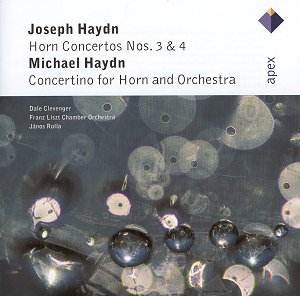Haydn (senior) was appointed to the Esterházy
court in 1761. He arrived to find most of his non-string players, in
other words the winds and brass, had been recruited from the local army
bands, the so-called Feldharmonie. Though this arrangement was necessarily
unsatisfactory, a year later matters had considerably improved when
there was a change at Court as Nikolaus succeeded his late brother Anton.
Nikolaus proved to be far more sympathetic to the arts in general and
to music in particular. This attracted good players, especially when
they got wind (no pun intended) of the fact that salaries there were
better even than those on offer at the Imperial Court in Vienna. Among
these new recruits were horn players Thaddäus Steinmüller
and Johannes Knobloch for whom Haydn wrote these two horn concertos
(and others besides, either singly or for two horns and some of them
not extant). The first D major concerto (No.3) survives in manuscript
and is definitely by Haydn; the other one exists only in a copyistís
hand and there are apparently some doubts as to its authenticity. Though
not a touch on Mozartís four concertos for the same instrument, written
a quarter of a century later for Ignaz Leutgeb, they prove to be enjoyable
works and cover a wide range of possibilities as far as the horn is
concerned, for at this time it was still valveless and highly treacherous
to play. There was also the pioneering work being done at the time by
Anton Hampel introducing slide works to the instrument, which Haydn
also made use of. There is a wide variety of colour and tone in the
writing, much more use of the lower register than Mozart ever used,
for example, and the best music reserved for the expressive slow movements.
Haydnís younger brother, Michael, has always been a
rather more obscure figure, lurking in the shadow of either his older
brother or of Mozart. From 1763 and for 43 years, Michael spent his
career in the service of the Prince-Archbishops of Salzburg. The second
of them was Colloredo, who infamously had Mozart kicked out of his service
(whereupon Haydn succeeded him as organist adding it to his already
secure posts of Kapellmeister and Konzertmeister). Michael Haydn got
on well with the Mozart family and even collaborated with the 11 year-old
prodigy and a third composer (Adlgasser) on an oratorio, to which each
contributed a third of the music. Michael was a prolific composer, with
38 masses, secular vocal music, Singspiel operas (that is those with
spoken dialogue), 40 symphonies, concertos and chamber music to his
name. His Requiem, like Mozartís, was unfinished and was known by his
younger contemporary (resulting in some striking similarities when it
comes to Mozartís work). The Concertino included here probably comes
from his early Salzburg years, in the 1760s; in other words more or
less at the same time as his older brotherís essays in the same genre.
Unusually structured, the sequence of its three movements progresses
from a slow Larghetto, followed by an Allegro and finally a Minuet.
This probably implies that this is a fragment of an intended larger-scale
work. It had been his habit to write Serenades among which were movements
which highlighted one or more virtuosi in his 100 strong Salzburg orchestra.
These movements tended to be circulated separately thereafter, so the
three put together to form this Concertino may well have had a quite
different antecedence.
In this post-Dennis Brain era, horn players have to
be virtuosi of the highest calibre. Dale Clevenger (about whom nothing
can be deduced from the CD bookletís total lack of information about
him) generally produces the goods, apart from one or two high notes
on the cusp. He plays his own cadenzas to all three works, if not always
sufficiently sustaining their style. The Franz Liszt Chamber Orchestra,
with occasionally audible, but delightful, harpsichord continuo under
János Rolla gives sterling support.
Christopher Fifield

![]() Dale Clevenger, horn
Dale Clevenger, horn ![]() TELDEC APEX 0927 40825
2 [51.00]
TELDEC APEX 0927 40825
2 [51.00]